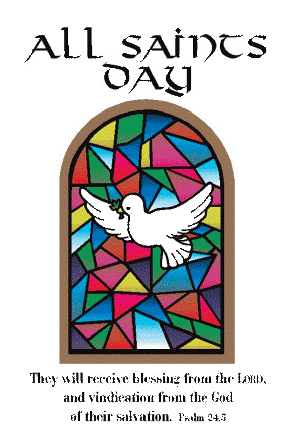All Souls - Remembering our Loved onesThe Reverend Charles Royden looks atHalloween, All Saints and All Souls1 November 2003 |
Explaining Halloween, All Saints and All Souls
Halloween
The last day of October marks the beginning in the church of a period known as Hallowtide 'All Saintstide' when Christian remember those who have died. All-Hallows Eve, or Halloween, October 31 has Celtic origins being originally the feast of Sanhain/Samhain,(pronounced 'sow'inn) the last night of the Celtic year, when all kinds of spirits were thought to be active. The Celts believed that this was a time when the boundary between the spirit world and the earthly world is at its thinnest and when spirits are most likely to be seen on earth. It was a night of danger signifying the change from Autumn to Winter, it was a night when feasts were held for the dead and animals killed for the Winter. On this night fires were lit in the belief that light had power over darkness, hence pumpkin lanterns to frighten away witches and ghosts. When the Romans invaded Britain they included elements of their harvest celebrations in which they honoured the goddess of the fruits of trees, Pomona. Children still play games with apples at this time of year.
So when did Sanhain become Halloween? By the 9th century Christianity had spread into Celtic lands and the celebration became known as the Eve of All Hallows and eventually Halloween.
All Saints Day, (All Hallows) November 1
The word Hallow means 'Holy', (blessed, consecrated or set apart in a special way) and so 'All-Hallows' or 'All Saints' refers to the Saints—the Holy Ones. Those who died for their faith or who lived extraordinary lives. This day dates back to the 5th century Antioch in Syria when the church dedicated a day to the memory of all those who had been killed for their faith. Until then the church had remembered martyrs on special days of the year, but there became more martyrs than days in the year, and there were some whose names were not known. In Rome Boniface IV (608-615) had relics of martyrs moved from the catacombs to the Pantheon. In 835 the 1st of November was given the title 'All Saints.'
- St. Martin of Tours is represented by a cloak which he cut in half to give to a shivering beggar
- Catherine of Alexandria is shown with a spiked wheel
- St. Sebastian usually holds an arrow—as a reminder of the terrible methods of their respective martyrdoms.
The saints are our ancestors on earth and precede us in heaven. Many Christians experience a strong sense that the saints are still with us, and that they watch over us and pray to God for us. The prayer from Methodist Worship at the bottom of this page expresses the idea of knowing their fellowship with us. Although dead, they are members of Christ's Church and we use this day to give thanks for the lives of all the saints as they are examples to us. Saints are created as signs of hope, that the gospel really can change lives. Somebody is not made a saint at canonisation, it is rather an acknowledgement that somebody was a saint and is therefore in heaven and not neglectful of the needs of the world, through the communion of saints.
All Souls Day, November 2
In the New Testament, 'saint' is often used to describe all those who are followers of Christ, the people called to holiness in him. Not just those who were extra-specially good. So does this apply to Christians now? Are all saints? The answer must be Yes! So on this day we pray not just for those who have been specially recognised as Saints, but for all of our loved ones. In 1048 Odilo, the Abbot of the Benedictine Monastery at Cluny near Paris instructed his monks to use this day as a day of remembrance and prayer for all the departed, this day was made official in the 14C.
In the Christian Church we remember the Church not just as those who are
living but also those who have died, they are just as much the church as we
are and the Christian Church has two names for this, those who are living
are called the church militant, and those have died are called the church
triumphant.
This time of year is an important time to cherish the memory of those who
have died and who have gone before us. As we celebrate their memory we can
know and be glad that they share with us in Christ's eternal kingdom. People
find the whole idea of death difficult and to have a special day to remember
those who have died is not an easy thing for some people. At this time in
the year of the church we can really think and speak about those who have
died and not in hushed tones. We can remember and feel our loss. We
celebrate the lives of those whom we have known and love and we pray for
their peace.
- Holy God you have called witnesses from every nation and revealed your glory in their lives.
- Grant us the same faith and love that, following their example,
- we may be sustained by their fellowship and rejoice in their triumph;
through Jesus Christ our Lord. Amen.

